
Wallachia or Walachia is a historical and geographical region of Romania. It is situated north of the Lower Danube and south of the Southern Carpathians. Wallachia is traditionally divided into two sections, Muntenia and Oltenia. Wallachia as a whole is sometimes referred to as Muntenia through identification with the larger of the two traditional sections.

Craiova, is Romania's 6th largest city and capital of Dolj County, and situated near the east bank of the river Jiu in central Oltenia. It is a longstanding political center, and is located at approximately equal distances from the Southern Carpathians (north) and the River Danube (south). Craiova is the chief commercial city west of Bucharest and the most important city of Oltenia. The city prospered as a regional trading centre despite an earthquake in 1790, a plague in 1795, and a Turkish assault in 1802 during which it was burned.
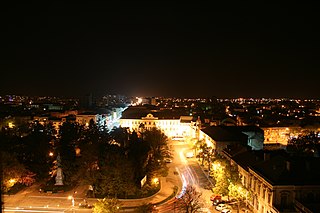
Brăila is a city in Muntenia, eastern Romania, a port on the Danube and the capital of Brăila County. The Sud-Est Regional Development Agency is located in Brăila.

Isaccea is a small town in Tulcea County, in Northern Dobruja, Romania, on the right bank of the Danube, 35 km north-west of Tulcea. According to the 2011 census, it has a population of 4,955.
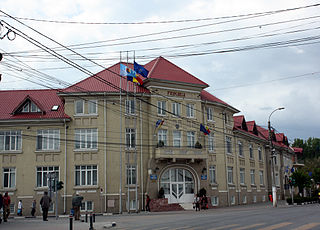
Giurgiu is a city in southern Romania. The seat of Giurgiu County, it lies in the historical region of Muntenia. It is situated amongst mud-flats and marshes on the left bank of the Danube facing the Bulgarian city of Ruse on the opposite bank. Three small islands face the city, and a larger one shelters its port, Smarda. The rich grain-growing land to the north is traversed by a railway to Bucharest, the first line opened in Romania, which was built in 1869 and afterwards extended to Smarda. Giurgiu exports timber, grain, salt and petroleum, and imports coal, iron, and textiles.
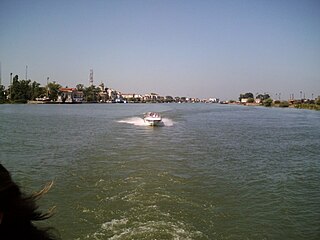
Sulina is a town and free port in Tulcea County, Northern Dobruja, Romania, at the mouth of the Sulina branch of the Danube. It is the easternmost point of Romania.
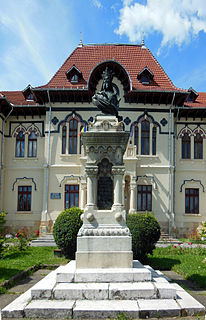
Câmpulung, or Câmpulung Muscel, is a municipality in the Argeș County, Muntenia, Romania. It is situated among the outlying hills of the Carpathian mountains, at the head of a long well-wooded glen traversed by the Râul Târgului, a tributary of the Argeș.

Măcin is a town in Tulcea County, in the Northern Dobruja region of Romania.
Pereyaslavets or Preslavets was a trade city located near mouths of the Danube. The city's name is derived from that of the Bulgarian capital of the time, Preslav, and means Little Preslav. In Greek it was also known as Presthlavitza (Πρεσθλαβίτζα). Several theories exist regarding the exact location of the city: either at Preslav or in its vicinity in Bulgaria, or at Isaccea, Nufăru, Murighiol or Jurilovca in Romania.

The Basarabs were a family which had an important role in the establishing of the Principality of Wallachia, giving the country its first line of Princes, one closely related with the Mușatin rulers of Moldavia. Its status as a dynasty is rendered problematic by the official elective system, which implied that male members of the same family, including illegitimate offspring, were chosen to rule by a council of boyars. After the rule of Alexandru I Aldea, the house was split by the conflict between the Dănești and the Drăculești, both of which claimed legitimacy. Several late rulers of the Craiovești claimed direct descent from the House after its eventual demise, including Neagoe Basarab, Matei Basarab, Constantin Șerban, Șerban Cantacuzino, and Constantin Brâncoveanu.

Greeks are a historic minority group in Romania. At times, as during the Phanariote era, this presence has amounted to hegemony; at other times, the Greeks have simply been one among the many ethnic minorities in Romania.

The Despotate of Dobruja or Principality of Karvuna was a 14th-century quasi-independent polity in the region of modern Dobruja, that split off from the Second Bulgarian Empire under the influence of the Byzantine Empire.

The Saint Sava National College, Bucharest, is the oldest and one of the most prestigious high schools in Romania. It was founded in 1694, under the name of the Royal Academy of Bucharest.
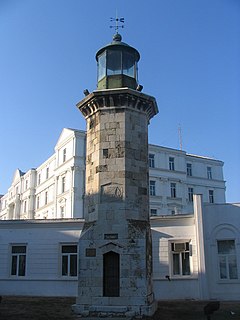
The Italians in Romania are people of Italian descent who reside, or have moved to Romania.

Dobrotitsa was a Bulgarian noble, ruler of the de facto independent Principality of Karvuna and the Kaliakra fortress from 1354 to 1379–1386.
The foundation of Wallachia, that is the establishment of the first independent Romanian principality, was achieved at the beginning of the 14th century, through the unification of smaller political units that had existed between the Carpathian Mountains, and the Rivers Danube, Siret and Milcov.
During the Mongol invasion of Europe, Mongol tumens led by Batu Khan and Kadan invaded Serbia and then Bulgaria in the spring of 1242 after defeating the Hungarians at the battle of Mohi and ravaging the Hungarian regions of Croatia, Dalmatia and Bosnia.

Andronikos Kantakouzenos, also known as Mihaloğlu Derviş, was an Ottoman Greek entrepreneur and political figure, primarily active in Wallachia and Moldavia. He was the son of Michael Kantakouzenos Şeytanoğlu, a powerful merchant of the Ottoman Empire, executed by Murad III in 1578. Forced to honor his father's outstanding debt, and briefly imprisoned as a galley slave, he rebuilt the fortune through commerce and political intrigues. In the 1590s, he was continuing his father's involvement as kingmaker for both Wallachia and Moldavia, acting as patron for a succession of Hospodars: Stephen the Deaf, Petru Cercel, Aaron the Tyrant and Peter the Lame all benefited from his financing. From 1591, he involved himself directly in the administration of both countries. Integrated within Moldo–Wallachian boyardom, he was Vistier, and then the first-ever Ban of Oltenia to be appointed directly by the Ottomans.

Romanian Revival architecture is an architectural style that has appeared in late 19th century in Romanian Art Nouveau, initially being the result of the attempts of finding a specific Romanian architectural style. The attempts are mainly due to the architects Ion Mincu (1852-1912), and Ion N. Socolescu (1856-1924). The peak of the style was the interwar period. The style was a national reaction after the domination of French-inspired Classicist Eclecticism. Apart from foreign influences, the contribution of Romanian architects, who reinvented the tradition, creating, at the same time, an original style, is manifesting more and more strongly. Ion Mincu and his successors, Grigore Cerchez, Cristofi Cerchez, Petre Antonescu, or Nicolae Ghica-Budești declared themselves for a modern architecture, with Romanian specific, based on theses such as those formulated by Alexandru Odobescu around 1870:
"Study the remains - no matter how small - of the artistic production of the past and make them the source of a great art (...) do not miss any opportunity to use the artistic elements presented by the Romanian monuments left over from old times; but transform them, change them, develop them ..."


















